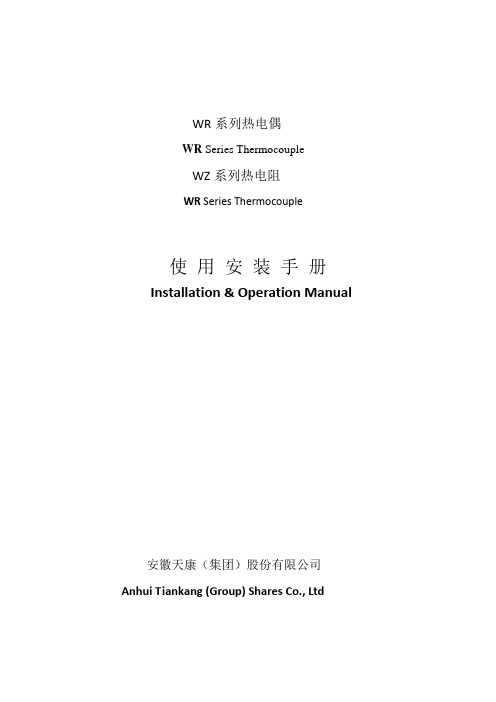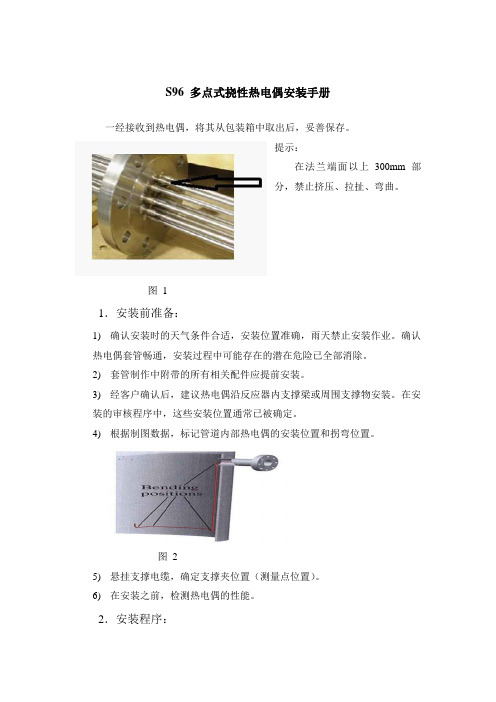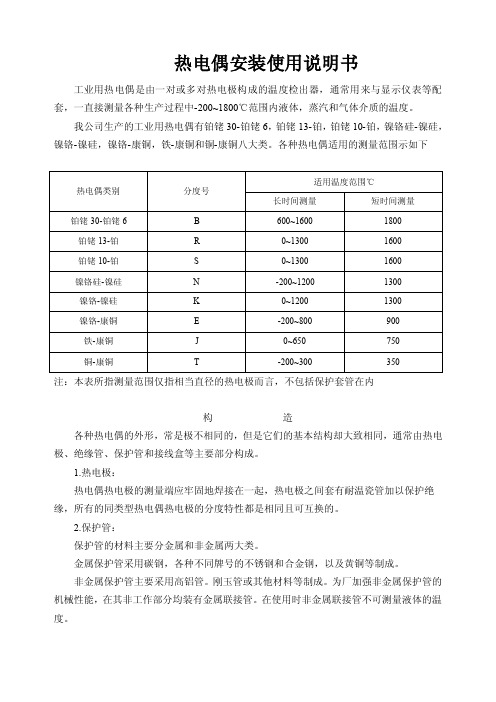热电偶安装手册
热电偶使用说明书

热电偶使用说明书使用说明书一、产品概述热电偶(下文简称“本产品”)是一种温度测量仪器,广泛应用于工业领域中的温度检测和控制。
本产品采用热电效应原理,通过测量电压来确定被测物体的温度。
本使用说明书旨在帮助用户正确、安全地使用本产品。
二、产品特点1. 高精度:本产品采用精密的传感器和先进的技术,能够提供高度准确的温度测量结果。
2. 快速响应:本产品响应速度快,可迅速准确地测量温度变化,满足工业生产对实时温度监控的需求。
3. 耐高温:本产品采用耐高温材料制作,能够在高温环境下长时间稳定运行。
4. 易于安装:本产品采用标准接口设计,方便用户进行安装和更换。
三、使用方法1. 安装本产品时,需先确保被测物体的表面干净、平整,并清除表面积聚的杂质,以免影响测量准确性。
2. 将本产品的接头与温度测量仪器的连接器插口对准,并插紧,确保连接稳固可靠。
3. 连接完成后,使用前请确保连接处无短路或断路现象,防止测量结果出现误差。
4. 使用过程中,应注意避免本产品与湿气、水和腐蚀性物质直接接触,以免影响使用寿命和测量准确性。
5. 在使用期间,如发现本产品表面有异物附着或损坏现象,请及时清理或更换,确保使用效果和安全。
6. 为了确保测量结果的准确性和稳定性,建议定期对本产品进行校准,具体校准方法可参考附带的校准手册。
四、安全注意事项1. 使用本产品时,请勿触碰本产品的金属部分,以免发生触电或烫伤等事故。
2. 请勿将本产品暴露在高温、潮湿或有腐蚀性气体的环境中,以免损坏产品和影响使用效果。
3. 在更换或清洁本产品时,请务必切断电源,并等待本产品冷却后再操作。
4. 若本产品出现故障或异常情况,请立即停止使用,并联系售后服务部门进行检修或更换。
5. 请勿私自拆卸或改装本产品,以免引发故障或安全事故。
五、维护保养1. 使用本产品后,请拔掉电源线,存放在干燥、通风良好的地方,防止产品受潮或受损。
2. 定期检查本产品的接线是否松动,如有松动请及时进行固定。
热电偶、热电阻温度计安装方式

热电偶、热电阻温度计安装方式
1.安装使用注意事项:
按照被测介质的特性及操作条件。
选用合适材质、厚度及结构的保护套管和垫片。
热电偶安装的地点、深度、方向和接线应符合测量技术的要求。
热电偶与补偿导线接头处的环境温度最高不应超过100℃。
使用于0℃以下的热电偶,应在其接线座下灌蜡密封,使其与外界隔绝。
2.热电偶、热电阻温度计安装方式
a.直形连接头:直插。
b.45°角连接头:斜插。
c.法兰:直插。
d.高压套管(有固定套管和可换套管)。
3.热电阻、热电偶在耐酸钢扩大管上安装图
a.垫片
b.45度角连接图
c.温度计扩大管
4.热电阻、热电偶在钢肘管上安装图
a.垫片
b.45°角连接图
5.表面热电偶安装图
材料是表面热电偶直形连接头
6.用翻边松套法兰固定的热电偶热电阻在铝管道上安装图
a.铝保护套管
b.翻边松套法兰接管。
热电偶安装手册(中英文)

WR系列热电偶WR Series ThermocoupleWZ系列热电阻WR Series Thermocouple使用安装手册Installation & Operation Manual安徽天康(集团)股份有限公司Anhui Tiankang (Group) Shares Co., Ltd目录Index1、概述General Description (1)2、工作原理Operation Theory (1)3、结构Configuration (2)4、主要技术参数Main Technical Parameters (3)5、安装及使用Installation & Operation (5)6、可能发生的故障及维修Possible Troubles & Maintenance (7)7、运输及储存Transportation & Storage (8)8、订货须知Notices in Ordering (8)9、型号命名Type Naming (9)1、概述General Description工业用热电偶作为温度测量和调节的传感器,通常与显示仪表等配套,以直接测量各种生产过程中-40~1600℃液体、蒸汽和气体介质以及固体表面温度;As sensor for temperature measuring and regulation, industrial-purpose thermocouple is usually connected with display meter and other meters to directly measure temperature of liquid, vapor, gas and solid surface ranging from -40℃to 1600℃.工业用热电阻作为温度测量和调节的传感器,通常与显示仪表等配套,以直接测量各种生产过程中-200~500℃液体、蒸汽和气体介质以及固体表面温度。
热电偶安装校准

热电偶安装校准热电偶是一种常用的温度测量仪器,广泛应用于工业控制和实验室测试等领域。
为了确保热电偶测量的准确性,正确的安装和校准是非常重要的。
本文将介绍热电偶安装的步骤和校准方法。
1. 热电偶安装步骤热电偶的安装过程需要注意以下几个步骤:1.1 选择合适的安装位置:热电偶应安装在需要测量温度的位置上。
在选择位置时,应考虑温度分布的均匀性和测量的准确性。
1.2 清洁安装位置:在安装之前,应将安装位置清洁干净,以确保热电偶能够与被测物体充分接触,减少测量误差。
1.3 安装热电偶:将热电偶插入被测物体中,确保插入深度适当。
插入深度过浅或过深都会影响测量的准确性。
1.4 固定热电偶:使用合适的固定方法固定热电偶,防止其在使用过程中发生松动或移位。
2. 热电偶校准方法热电偶的校准是为了确认其测量结果的准确性,常用的校准方法有以下几种:2.1 冰点校准法:将热电偶放入冰水混合物中,使其达到稳定状态。
此时,热电偶的输出电压应为已知的冰点电动势。
2.2 沸点校准法:将热电偶放入水沸腾中,使其达到稳定状态。
此时,热电偶的输出电压应为已知的沸点电动势。
2.3 标准温度法:将热电偶与已知温度的标准温度计放置在同一环境中,比较两者的测量结果,从而确定热电偶的准确性。
2.4 其他校准方法:根据实际需要,还可以采用其他校准方法,比如使用标准温度计和标准电压源等。
3. 热电偶安装校准注意事项在进行热电偶的安装和校准时,需要注意以下几点:3.1 温度梯度:在安装热电偶时,要尽量避免温度梯度的存在。
温度梯度会导致测量结果不准确。
3.2 环境干扰:热电偶的测量结果可能会受到环境干扰的影响,比如电磁干扰、辐射干扰等。
在安装时,要注意避免这些干扰。
3.3 线路连接:热电偶的线路连接应牢固可靠,避免接触不良或接触松动,以免影响测量结果。
3.4 定期校准:热电偶的性能会随着使用时间的增长而逐渐变化,因此建议定期对热电偶进行校准,以确保测量结果的准确性。
S96 多点式挠性热电偶安装手册

S96 多点式挠性热电偶安装手册一经接收到热电偶,将其从包装箱中取出后,妥善保存。
提示:在法兰端面以上300mm部分,禁止挤压、拉扯、弯曲。
图11.安装前准备:1)确认安装时的天气条件合适,安装位置准确,雨天禁止安装作业。
确认热电偶套管畅通,安装过程中可能存在的潜在危险已全部消除。
2)套管制作中附带的所有相关配件应提前安装。
3)经客户确认后,建议热电偶沿反应器内支撑梁或周围支撑物安装。
在安装的审核程序中,这些安装位置通常已被确定。
4)根据制图数据,标记管道内部热电偶的安装位置和拐弯位置。
图25)悬挂支撑电缆,确定支撑夹位置(测量点位置)。
6)在安装之前,检测热电偶的性能。
2.安装程序:1)在S96型热电偶安入反应器前,必须将其整顺。
2)在装入的热电偶上标记每一个拐点的位置。
3)标记完后,将多点式热电偶置于管嘴前。
图3:不要让四个支撑接触热电偶。
4)开始安装多点式热电偶。
将图2整个装置装入套管中,在装之前不要忘了提前将两个法兰之间的垫片装上。
5)法兰正确安装后紧固。
6)在反应器内部,热电偶的每一次弯曲标记都要很明显。
(热电偶的最小弯曲半径: 100 mm.)。
同上,将所有热电偶安到各自的位置。
7)将热电偶的顶部固定好后,其他的按照同样的过程安装(参照安装图及安装计划)。
8)一旦所有的热电偶全部装上后,应即可将它们通过支撑夹固定住(参照安装图)。
9)安装完毕后,再次检查热电偶的性能。
所有的脚手架,要求的设备及全体人员必须在安装之前到达安装指定位置,这样以来可减少不必要的等候和委托人的费用。
热电偶说明书

热电偶安装使用说明书工业用热电偶是由一对或多对热电极构成的温度检出器,通常用来与显示仪表等配套,一直接测量各种生产过程中-200~1800℃范围内液体,蒸汽和气体介质的温度。
我公司生产的工业用热电偶有铂铑30-铂铑6,铂铑13-铂,铂铑10-铂,镍铬硅-镍硅,镍铬-镍硅,镍铬-康铜,铁-康铜和铜-康铜八大类。
各种热电偶适用的测量范围示如下注:本表所指测量范围仅指相当直径的热电极而言,不包括保护套管在内构造各种热电偶的外形,常是极不相同的,但是它们的基本结构却大致相同,通常由热电极、绝缘管、保护管和接线盒等主要部分构成。
1.热电极:热电偶热电极的测量端应牢固地焊接在一起,热电极之间套有耐温瓷管加以保护绝缘,所有的同类型热电偶热电极的分度特性都是相同且可互换的。
2.保护管:保护管的材料主要分金属和非金属两大类。
金属保护管采用碳钢,各种不同牌号的不锈钢和合金钢,以及黄铜等制成。
非金属保护管主要采用高铝管。
刚玉管或其他材料等制成。
为厂加强非金属保护管的机械性能,在其非工作部分均装有金属联接管。
在使用时非金属联接管不可测量液体的温度。
3.接线盒:热电偶接线盒系供连接热电偶参比端与显示仪表之用。
接线盒一般用铝合金制成并分防溅式,防水式及插接式等结构形式。
4.安装固定装置:热电偶的安装固定装置供用户安装固定之用。
它分无固定装置、固定螺纹活动法兰、固定法兰、卡套螺纹、卡套法兰等形式。
技术特性1.热电偶的允差如下表中所示:(参与端处于0℃)℃注:t为被测温度(℃),在同一栏给出的两种允差值中,取绝对值较大者。
在-40℃以上的温度范围符合Ⅰ、Ⅱ级允差的T、E、K、N型热电偶,又要求在-40℃以下符合Ⅲ级允差时,由供需双方商定。
2.热响应时间:在温度出现阶跃变化时热电偶的输出变化至相当于该阶跃变化的50%所需的时间。
通常以t0.50表示。
参比端温度补偿热电偶的热电动势与温度关系所制定的分度表,是在参比端为0℃时分度的。
真空炉热电偶安装方法
真空炉热电偶安装方法
真空炉热电偶是用于测量高温下材料温度的测量设备。
正确安装热电偶是保证实验数据准确性的关键。
以下是真空炉热电偶安装的步骤:
1. 准备两种不同材质的金属线,用来制作热电偶的两端。
2. 将两根金属线分别插入夹持器中,用钳子紧固,使其固定在夹持器上。
注意,金属线的长度应该足够长,以便作为热电偶的尾部。
3. 将两根金属线锡焊在一起,使其成为一个热电偶。
4. 将热电偶的尾部接上对应的导线,在真空炉内部经过合适的导管并穿过真空炉壁安装在炉外。
5. 将热电偶的补偿导线接到补偿妆具上,保证热电偶测量的准确性。
6. 最后,检查热电偶的安装是否牢固,是否脱离导线和妆具,确认连接是否正确无误。
安装好热电偶之后,实验者应该在使用真空炉前校准热电偶的测量准确性,以确定实验数据的精确性。
热电偶的安装方法
正确使用热电偶不但可以准确得到温度的数值,保证产品合格,而且还可节省热电偶的材料消耗,既节省资金又能保证产品质量。
安装不正确,热导率和时间滞后等误差,它们是热电偶在使用中的主要误差。
1、安装不当引入的误差如热电偶安装的位置及插入深度不能反映炉膛的真实温度等,换句话说,热电偶不应装在太靠近门和加热的地方,插入的深度至少应为保护管直径的8~10倍;热电偶的保护套管与壁间的间隔未填绝热物质致使炉内热溢出或冷空气侵入,因此热电偶保护管和炉壁孔之间的空隙应用耐火泥或石棉绳等绝热物质堵塞以免冷热空气对流而影响测温的准确性;热电偶冷端太靠近炉体使温度超过100℃;热电偶的安装应尽可能避开强磁场和强电场,所以不应把热电偶和动力电缆线装在同一根导管内以免引入干扰造成误差;热电偶不能安装在被测介质很少流动的区域内,当用热电偶测量管内气体温度时,必须使热电偶逆着流速方向安装,而且充分与气体接触。
2、绝缘变差而引入的误差如热电偶绝缘了,保护管和拉线板污垢或盐渣过多致使热电偶极间与炉壁间绝缘不良,在高温下更为严重,这不仅会引起热电势的损耗而且还会引入干扰,由此引起的误差有时可达上百度。
3、热惰性引入的误差由于热电偶的热惰性使仪表的指示值落后于被测温度的变化,在进行快速测量时这种影响尤为突出。
所以应尽可能采用热电极较细、保护管直径较小的热电偶。
测温环境许可时,甚至可将保护管取去。
由于存在测量滞后,用热电偶检测出的温度波动的振幅较炉温波动的振幅小。
测量滞后越大,热电偶波动的振幅就越小,与实际炉温的差别也就越大。
当用时间常数大的热电偶测温或控温时,仪表显示的温度虽然波动很小,但实际炉温的波动可能很大。
为了准确的测量温度,应当选择时间常数小的热电偶。
时间常数与传热系数成反比,与热电偶热端的直径、材料的密度及比热成正比,如要减小时间常数,除增加传热系数以外,最有效的办法是尽量减小热端的尺寸。
使用中,通常采用导热性能好的材料,管壁薄、内径小的保护套管。
热电偶操作说明书
热电偶操作说明书一、简介热电偶是一种用于测量温度的设备,基于热电效应原理工作。
本操作说明书将详细介绍热电偶的组成部分、使用方法、注意事项以及维护保养等内容,以确保您正确、安全地操作热电偶。
二、组成部分热电偶由以下部分组成:1. 保护管:用于保护热电偶元件,通常由不锈钢、钨铼合金等材料制成。
2. 热电偶元件:由两种不同金属(如铜和铜镍合金)焊接而成,产生热电效应。
3. 连接头:连接热电偶和仪表,通常采用标准连接头,如K型、J 型等。
三、使用方法1. 确认热电偶类型:根据实际应用需求,选择适合的热电偶类型,如K型热电偶适用于-200°C 至 1250°C 温度范围。
2. 安装热电偶:将保护管固定在待测介质中,注意保护管应完全暴露在待测介质中,保证准确测量。
3. 连接仪表:将热电偶的连接头与仪表进行连接,保证连接牢固可靠。
4. 校准:在测量之前,根据具体设备的要求进行校准。
注意校准应在常温环境下进行,并根据仪表的指示调整。
四、注意事项1. 安全操作:使用热电偶时请注意防止热电偶过热,避免烫伤。
同时,注意避免与化学物质接触,以防腐蚀热电偶或影响测量准确性。
2. 温度限制:请确保热电偶工作温度在规定的范围内,超出范围可能会损坏热电偶或导致不准确的测量结果。
3. 避光干扰:热电偶遇到强光时可能产生干扰,请避免热电偶暴露在强光中,以保证测量准确性。
4. 清洁与维护:定期清洁热电偶以去除附着物,避免堵塞保护管;注意保持连接良好,以免影响测量信号。
五、故障与处理1. 信号异常:如果热电偶信号异常或不稳定,请检查连接部分是否松动,确认连接良好。
2. 测量不准确:如果测量结果偏离实际值,请检查热电偶是否受损或保护管是否被污染。
如需要更高精度测量,请进行校正或更换适合的热电偶。
3. 其他故障:如遇其他故障,请联系专业人员进行检修或更换。
六、免责声明在正常使用过程中,若因不正当操作或其他原因导致热电偶损坏或测量结果不准确,本产品概不负责。
热电偶操作流程
热电偶操作流程热电偶是一种常用的温度测量设备,广泛应用于工业生产、实验室研究等领域。
本文将介绍热电偶的操作流程,包括选择热电偶类型、安装热电偶、连接热电偶、测量温度等步骤。
一、选择热电偶类型在选择热电偶之前,需要了解测量温度的范围、环境条件以及测量精度等要求。
常见的热电偶类型包括K型、J型、T型等,不同类型的热电偶适用于不同范围的温度测量。
根据具体的需求,选择适合的热电偶类型。
二、安装热电偶1. 准备工作:首先,查看热电偶是否完好无损,并使用万用表检测热电偶的电阻值,确保正常工作。
另外,清洁被测物体的表面,确保无任何杂质。
2. 固定热电偶:将热电偶置于要测量的物体表面,并使用固定夹具或电缆扎带将热电偶固定在位置上。
注意保证热电偶与物体表面充分接触。
三、连接热电偶1. 准备工作:检查热电偶的电缆是否完好,确保无损坏。
通过外观检查和万用表测量,确认热电偶连接线路正确。
2. 连接接线头:根据热电偶和测量仪表的接口规格,将热电偶的连接线与测量仪表进行连接。
注意保证连接牢固,避免接触不良。
四、测量温度1. 开启电源:将测量仪表的电源开关打开,确保供电正常。
有些仪表还需要校准或者设置温度范围等参数,操作前务必阅读使用手册。
2. 读取温度:根据测量仪表的显示屏,可以直接读取被测物体的温度数值。
一定要注意观察仪表的测量单位以及小数位数等。
3. 记录数据:根据需要,可以将测得的温度数值记录下来。
可以通过纸质表格、电子表格或者记录仪表等方式进行记录,确保数据的准确性。
需要注意的是,热电偶操作时要注意防火安全和操作规范。
特别是在测量高温物体时,要保证自身和周围环境的安全。
总结:热电偶的操作流程包括选择热电偶类型、安装热电偶、连接热电偶和测量温度等步骤。
根据具体的需求和使用要求,选择适合的热电偶类型,并正确安装在被测物体上。
连接热电偶时,确保连接线路正确和牢固。
在测量温度时,注意供电和仪表设置,并合理记录测得的温度数据。
- 1、下载文档前请自行甄别文档内容的完整性,平台不提供额外的编辑、内容补充、找答案等附加服务。
- 2、"仅部分预览"的文档,不可在线预览部分如存在完整性等问题,可反馈申请退款(可完整预览的文档不适用该条件!)。
- 3、如文档侵犯您的权益,请联系客服反馈,我们会尽快为您处理(人工客服工作时间:9:00-18:30)。
感温元件直径及材料Diameter & Material of Thermal Elements
热电偶Thermocouple
偶丝形式
FilamentForm
套管直径
TubeDiameter
套管材质Tube Material
E﹑J﹑T
K﹑N
S
单支式
Filament Form
接线盒防护等级IP65; Protection Class of Junction Box: IP65
防水接线盒结构图 Structural Figure of Junction Box
安装固定装置Installation & Fixing Devices
卡套螺纹接头Threaded HeadwithFastener
热响应时间Thermal Response Time
当温度出现阶跃变化时,仪表的电流输出信号变化至相当于该阶跃变化的50%所需的时间,通常以τ表示
Whenstep change of temperature happens,τ is used to indicate the time for current output signal of instrument changes into 50% of the step change value.
制造热电阻的材料应具有以下特点:大的温度系数,大的电阻率,稳定的化学物理性能和良好的复现性等。在现有的各种纯金属中,铂、铜和镍是制造热电阻的最合适的材料。其中铂因具有易于提纯,在氧化性介质中具有高的稳定性以及良好的复现性等显著的优点,而成为制造热电阻的理想材料。
It is based on that temperature change of material results in change of its resistance. When resistance value changes, the working instrument will display relevant temperature.
卡套Fastener 扳手Spanner 固定卡套Fixed Fastener 可动卡套Movable Fastener
代号和尺寸
Code & Size
铠装偶外径dOuter Diameter of Armored Thermocouple
Φ8
Φ6
Φ5
Φ4
Φ3
Φ2
M
M16×
M12×
S
22
19
固定螺纹式Threaded Connector
1Cr18Ni9TI
Φ4
Φ5
Φ6
Φ8
双支式
Duplex
Φ4
Φ5
Φ6
Φ8
接线盒 Junction Box
接线盒供连接热电偶、热电阻参比端和显示仪表之用;
Junction box is for connection between reference end of thermocouple and display instrument.
绝缘电阻用MΩ表示,即为常温绝缘与热电偶长度的乘积,对于长度小于1m的热电偶按1m计算。
The unit is MΩ·m,or product of insulation resistance and thermocouple length. Thermocouple withlengthless than 1m is considered as 1m. in calculation.
WRE
E
±℃
-40~+375
±℃
-40~+333
±|t|
375~800
±|t|
333~900
WRP
S
±1℃
0~+1100
±℃
0~600
±[1+
(t-1100)]
1100~1600
±|t|
600~1600
WRR
B
―
―
―
―
―
―
±|t|
600~1700
注:t为实际温度,允许可用温度度数表示,也可用实际温度的百分数表示,取其大者。
6、可能发生的故障及维修Possible Troubles & Maintenance………7
7、运输及储存Transportation & Storage……………………………8
8、订货须知Notices in Ordering………………………………………8
9、型号命名Type Naming………………………………………………9
WR系列热电偶
WR
WZ系列热电阻
WR
使用安装手册
Installation & Operation Manual
安徽天康(集团)股份有限公司
AnhuiTiankang (Group) Shares Co., Ltd
Index
1、概述General Description………………………………………….1
热电偶的热电动势随着测量端温度的升高而增大,它的大小只与热电偶的材料和热电偶两端的温度有关,而与热电级的长度、直径无关。
Thermocouple is based on physical phenomenon that two conductor of different materials is connected to form return circuit, when temperature on both contact is different, it results in thermoelectric potential in return circuit.
2、工作原理Operation Theory
热电偶工作原理Operation Theory of Thermocouple
热电偶工作原理是基于两种不同成分的导体两端连接成回路,如两连接端温度不同,则在回路内产生热电流的物理现象。
热电偶由两根不同导线(热电极)A和B组成,它们的一端T1是互相焊接的,形成热电偶的测量端T1(也称工作端)。将它插入待测温度的介质中;而热电偶的另一端T0(参比端或自由端)则与显示仪表相连,如果热电偶的测量端与参比端存在温度差,则显示仪表将指出热电偶产生的热电动势。
工业用热电阻作为温度测量和调节的传感器,通常与显示仪表等配套,以直接测量各种生产过程中-200~500℃液体、蒸汽和气体介质以及固体表面温度。
As sensor for temperature measuring and regulation, industrial-purpose thermal resistance is usually connected with display meter andother meters to directly measure temperature of liquid, vapor, gas and solid surface ranging from -200℃ to 500℃.
分度号
Graduation
测温范围
Measuring Range
精度等级
Accuracy Class
允许偏差
Tolerance
Pt100
-200~+500
A级
±+ltl
B级
±+ltl
防护等级:IP65 Protection Class: IP65
常温绝缘电阻Insulation Resistance under Normal Temperature
热电偶Thermocouple
热电偶在环境温度为20±15℃,相对湿度不大于80%,试验电压为500±50V(直流)电极与外套管之间的绝缘电阻≥100MΩ.m。
Insulation resistance between electrode and outer tube is no less than 100MΩ·m under condition that ambient temperature is 20±15℃, relative humidity is no more than 80%, and test voltage is 500±50V .).
公称压力Nominal Pressure
一般是指室温下保护管所能承受的静态外压力而不破裂,试验压力取公称压力的倍。允许工作压力不仅与保护管材料、直径、壁厚有关,还与其结构形式、安装方法、插入深度以及被测介质的温度、流速和种类有关。
It generally refers to the sustainable static pressure from outside on protection tube without breakage.It concern not only material, diameter & wall thickness of protection tube, but the structure, mounting way,insert length, flow speed and category of tested media as well.
Notes: t is the actual temperature. It may be indicated with temperature centigrade or percentage of centigrade, the bigger one ispreferred.
热电阻Thermal Resistance
2、工作原理Operation Theory………………………………………………1
3、结构Configuration…………………………………………………2
